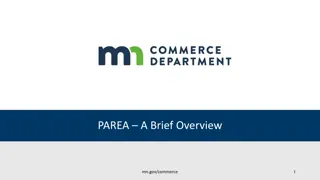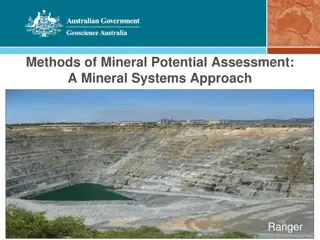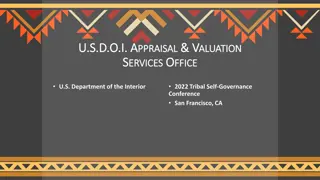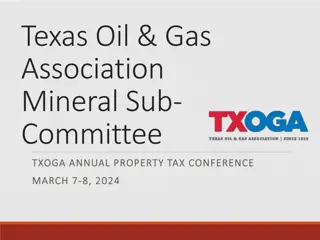Understanding Mineral Project Valuation and Appraisal Methods
This presentation by the Australasian Institute of Minerals Valuers & Appraisers delves into the importance of mineral property valuations, the methods used for valuation, the roles of valuers and technical appraisers, and the overall process involved. It highlights the necessity of valuations in various scenarios such as investment analysis, financial reporting, and legal proceedings, emphasizing the significance of determining the fair market value of mineral assets.
Download Presentation

Please find below an Image/Link to download the presentation.
The content on the website is provided AS IS for your information and personal use only. It may not be sold, licensed, or shared on other websites without obtaining consent from the author. Download presentation by click this link. If you encounter any issues during the download, it is possible that the publisher has removed the file from their server.
E N D
Presentation Transcript
Presented to GPIC/AIG April 2015 Presenters: Phillip Thomas, BSc Geol, MBM, MAIG, MAIMVA (CMV) Dr Carlos Sorentino, PhD, MEnvSt, BSc, FAusIMM, MAIMVA(CMV)
Australasian Institute of Minerals Valuers & Appraisers THE VALUATION OF MINERAL PROJECTS DISCLAIMER This presentation has been prepared for the purposes of discussion into the use and application of appraisal methods used for the valuation of exploration properties and in proposed, new and operating mines. It makes reference to the Valmin Code, 2005 Edition and the JORC Code 2013 and contains opinions and comments that are intended to assist in the understanding of technical issues that arise in valuation and technical due diligence. It is aimed solely at educational issues in relation to those objectives and should not be used or relied upon for any other purpose. The opinions expressed herein are those of the authors and do not necessarily reflect those of any organisation or company that may be involved in mineral industry valuation or appraisal activities. 2
Australasian Institute of Minerals Valuers & Appraisers THE VALUATION OF MINERAL PROJECTS THE VALUATIONOF MINERAL PROJECTS Why are mineral property valuations required? How are mineral property valuations carried out? Who does a mineral property valuation? What are the roles of Valuers and Technical Appraisers? What is AIMVA? Objectives, practitioners qualifications METHODSOF VALUATION Methods that may be used to value projects o Cost o Income o Market Methods based on the status of the project VALUATIONSAS OPINIONS 3
Australasian Institute of Minerals Valuers & Appraisers THE VALUATION OF MINERAL PROJECTS WHY ARE MINERAL PROPERTY VALUATIONS REQUIRED? Valuation is the process of estimating what something is worth. Items that are usually valued are financial assets or liabilities where there is no immediate market value. Valuations can be done on assets (for example, mineral properties at any stage of development) or on liabilities of a company. Valuations are needed for many reasons such as investment analysis, capital budgeting, merger and acquisition transactions, financial reporting, taxable events, and in litigation. Valuations are often required by statutory bodies such as: o Australian Taxation Office o States Stamp Duty offices o Australian Stock Exchange fro IPOs, mergers and acquisitions, etc o Courts of Law for commercial litigation cases 5
Australasian Institute of Minerals Valuers & Appraisers THE VALUATION OF MINERAL PROJECTS WHAT IS VALUE? Value is defined in the VALMIN Code as: the fair market value of a mineral or petroleum asset or security. It is the amount of money (or the cash equivalent of some other consideration) determined by the expert in accordance with the provisions of the VALMIN Code for which the mineral or petroleum asset or security should change hands on the valuation date in an open and unrestricted market between a willing buyer and a willing seller in an arm s length transaction, with each party acting knowledgeably, prudently and without compulsion.' 6
Australasian Institute of Minerals Valuers & Appraisers THE VALUATION OF MINERAL PROJECTS WHAT IS VALUE? In an strict economic sense, value is an amount, as goods, services, or money, considered to be a fair and suitable equivalent for something else; a fair price or return In an arm s length transaction between a willing buyer and willing seller, value is the price agreed by the parties to the transaction Value often needs to take into account considerations such as o Synergies o Particular circumstances o Discounts & premiums o Time of the transaction o Market & commercial factors 7
Australasian Institute of Minerals Valuers & Appraisers THE VALUATION OF MINERAL PROJECTS WHAT TOOLS ARE AVAILABLE FOR ESTIMATING MINERAL VALUATIONS? The VALMIN Code statutory basis for valuation, not a handbook (Update pending from 2005) The JORC Code - basis for Mineral Resource and Ore Reserve estimates (effective 1 Jan 2013) Technical Appraisals what are the key areas? 8
Australasian Institute of Minerals Valuers & Appraisers THE VALUATION OF MINERAL PROJECTS HOW ARE MINERAL PROPERTY VALUATIONS CONDUCTED ? Classify the Mineral Asset/Project and Select the Most Appropriate Valuation Methodologies: Cost-based - Exploration (properties without Defined Resources) Income-based - Existing Operations or Definitive Feasibility Studies (DFS) Market-based - Comparable Exploration and Operational Entities 9
Methods based on the status of the project Exploration & advanced exploration Development/ production Method Pre-development Appraised value Primary method May be suitable Not suitable Multiples of exploration expenditure Primary method May be suitable Not suitable Geoscience factor Primary method May be suitable Not suitable Expenditure for last 10 years Primary method May be suitable Not suitable Geological risk method Primary method Not suitable Not suitable Probability-weighted DCF May be suitable Primary method Primary method Discounted cash flow (DCF) No suitable Primary method Primary method Real options/dynamic DCF method No suitable Primary method Primary method May be suitable (as a cross check) May be suitable (as a cross check) May be suitable(as a cross check) Joint venture terms method May be suitable(as a cross check) May be suitable(as a cross check) Mau be suitable (as a cross check) Benchmark method 10
Australasian Institute of Minerals Valuers & Appraisers THE VALUATION OF MINERAL PROJECTS WHAT ARE THE BASES OF MINERAL PROPERTY VALUATIONS? 1. Nominate the Date: All valuations are time dependent 2. Apply the Selected Methodologies: Technical (Intrinsic ) Value cost or income-based Determine possible Market-Based factors 3. Determine & Apply Market or Risk-Based Modifiers: Discounts, premiums - risks (sovereign, enviro., political) synergies, barriers Comparison of Value - comparable transactions or entities, other valuations. Fair Market Value combination of all factors, modified by a premium or discount 11
Australasian Institute of Minerals Valuers & Appraisers THE VALUATION OF MINERAL PROJECTS ROUNDUP OF VALUATION CHARACTERISTICS VALUATION IS NOTAN EXACT SCIENCE it is an OPINION of a realistic range of values VALUE IS SUBJECTIVE - in the eye of the beholder VALUE IS TIME DEPENDENT prices, circumstances, conditions VALUATIONS by competent and experienced valuers are highest and best use estimates based upon the most reliable available information together with subjective, experience-based inputs by the valuer VALUE is assigned through the selection of appropriate methodologies and providing an opinion as to what, from among them, is considered the most likely figure 12
Australasian Institute of Minerals Valuers & Appraisers THE VALUATION OF MINERAL PROJECTS HOW SHOULD COMPETENT VALUATIONS BE EXPRESSED? The results of more than one methodology, if possible (cost, market, income) Provide valuations within a range (Low High) Provide a preferred value taken within the range, or statistical summary Adopt appropriately rounded figures Clear statements of assumptions, data shortcomings , project risks, estimation risk, etc. Transparency of methodology, assumptions and of the subjective inputs/modifiers, together with appropriate risk assessment, provides a basis for confidence in value estimates . A VALUATION IS AN EXPERT S OPINION AT THE TIME IT IS EXPRESSED 13
Australasian Institute of Minerals Valuers & Appraisers THE VALUATION OF MINERAL PROJECTS WHO DOES A MINERAL PROPERTY VALUATION? Experts & Specialists (VALMIN 2005, Sections 37 & D10) Experts may be: (i) INDEPENDENT EXPERT If acting as an Independent Expert, you must: a) Be Competent (>10 years general experience, >5 years valuation) b) Be an industry professional, technically qualified c) Be a Member of an appropriate Professional Association (ii) If acting as a Representative Expert , you must: (a) Be Competent ; or (b) Use a Senior Specialist or (c) Engage technical Specialists. REPRESENTATIVE EXPERT 14
Australasian Institute of Minerals Valuers & Appraisers THE VALUATION OF MINERAL PROJECTS AUSTRALASIAN INSTITUTE OF MINERALS VALUERS & APPRAISERS WHAT ARE THE FEATURES OF AIMVA? A formal Australasian qualification recognising professionals in minerals valuation. Certification of qualifications through experience and practice, with a Code of Ethics Demonstrated competence to PEERS in valuation/appraisal and >10 years of experience Fundamental objectives - competence, reasonableness, transparency, independence Specifies compliance with applicable codes of practice - JORC, VALMIN, NI 43- 101 etc. AIMVA is a Professional Association, with an enforceable Code of Ethics 15
Australasian Institute of Minerals Valuers & Appraisers THE VALUATION OF MINERAL PROJECTS AUSTRALASIAN INSTITUTE OF MINERALS VALUERS & APPRAISERS WHAT ARE THE AIMVA OBJECTIVES? Provide competent professional minerals industry valuers & appraisers Dedicated to the unique needs of professional minerals valuers & appraisers Define the qualifications & ethical standards for minerals valuers & appraisers Provide regulators & industry with benchmarks of expertise Advance the profession of valuation & appraisal of mineral properties Provide a pool of valuation expertise for the minerals industry and its regulators 16
Australasian Institute of Minerals Valuers & Appraisers THE VALUATION OF MINERAL PROJECTS AUSTRALASIAN INSTITUTE OF MINERALS VALUERS & APPRAISERS For further information, please visit our website at http://www.aimva.com.au/ 17
Methods that may be used to value projects Cost methods Method Explanation of methodology Uses meaningful past exploration expenditures plus warranted future costs to test remaining exploration potential. Appraised value method Similar to the appraised value method but a prospectivity enhancement multiplier (PEM) is applied. Multiples of exploration expenditure method (MEE) Uses ratings of the main characteristics of mineral properties to determine the overall project value. The sum of expenditure over the previous 10 years may be used as a proxy for the market value of tenements other than a production right. Geoscience factor method Expenditure for last 10 years 19
Methods that may be used to value projects Income methods Method Explanation of methodology Based on estimating the value of a target resource and reflects the costs associated with completing each stage of exploration and the probability of progressing to each subsequent stage. Geological risk method A DCF incorporating measures of technical risk into probable cash flows by factoring in the probability of success. Probability-weighted DCF Net present value (NPV) performed on expected free cash flows over a project's life. Discounted cash flow (DCF) The valuation of the scenarios encountered by management using techniques applied to financial options. Real options/dynamic DCF method 20
Methods that may be used to value projects Market methods Method Explanation of methodology Based on the required participation expenditure in proving up or developing a property by the incoming party. Joint venture terms method The value of a project is estimated through comparisons with previous transactions involving similar projects. Benchmark method 21
Methods based on the status of the project Exploration & advanced exploration Development/ production Method Pre-development Appraised value Primary method May be suitable Not suitable Multiples of exploration expenditure Primary method May be suitable Not suitable Geoscience factor Primary method May be suitable Not suitable Expenditure for last 10 years Primary method May be suitable Not suitable Geological risk method Primary method Not suitable Not suitable Probability-weighted DCF May be suitable Primary method Primary method Discounted cash flow (DCF) No suitable Primary method Primary method Real options/dynamic DCF method No suitable Primary method Primary method May be suitable (as a cross check) May be suitable (as a cross check) May be suitable(as a cross check) Joint venture terms method May be suitable(as a cross check) May be suitable(as a cross check) Mau be suitable (as a cross check) Benchmark method 22
OVERCONFIDENCEIN VALUATIONS To gain an idea of how accurate and how precise are valuations, a database of 35 operating gold mines was compiled to compare the valuations with the actual operating performance [1] The data was selected on the following criteria: Every mine has a valuation done prior to the operation, The data base includes gold producers that have been in production for at least one full year; All information was extracted from official company reports, that is to say, all information is freely available to shareholders and to the general public. No information from newspaper or magazine articles, verbal and written communication with any company officials has been included.
TYPEOFGOLDMININGPROJECT Mining method Treatment method Open Cut 24 69% Underground 4 11% CIP/CIL 30 86% Combined OC/UG 1 3% Heap Leach 3 9% Tailings 4 11% Alluvial 2 6% Alluvials 2 6% Total 35 100% Total 35 100%
The parameters evaluated include: Capital expenditure, $ million. Plant performance, t/y. Annual Gold production, oz/y. Recovered grade, as a function of ore feed grades and metallurgical recovery, g Au/t. Mining costs, $/t ore treated. Unit costs, $/oz Au produced
DIFFERENCESBETWEENESTIMATESAND ACTUALVALUES Median Standard Deviation Recovered grade, g Au/t -18% 16% Au production, oz/y -14% 25% Plant Performance, t/y 4% 22% Capital expenditure, $ M 3% +22% Mining costs, $/t 4% +44% Unit costs, $/oz 20% +51%
AREESTIMATESOVERCONFIDENT? It is necessary to demonstrate in a statistically rigorous manner that these differences are not random, that is to say, that they are statistically significant. This is equivalent to postulate that the estimates are neither accurate nor precise and, in addition, that estimates are, in fact, overconfident. The non-parametric Wilcoxon Matched Pair Signed-Rank test was chosen to test this hypothesis.
WILCOXONMATCHEDPAIRSIGNED-RANKTEST Probability that the estimate is overconfident Recovered grade Au production Plant performance Capital expenditure Mining costs Unit costs 100.0% 99.8% 76.5% 82.3% 51.0% 99.7%
The Wilcoxon test proves the hypothesis that estimates used in valuations are overconfident. Hence, The estimates were neither accurate nor precise.
The convention used to calculate the differences implies that negative differences represent over-estimations, while positive differences portray under-estimations: Recovery and the goldproduction were overestimated Plantperformance, capitalexpenditure, miningcosts and unitcosts were underestimated. This statistical analysis proves that there is high degree of certainty that gold mining pre-production estimates released by companies are overconfident and do not reflect the actual conditions that will be encountered during operations.
Each of these parameters have a significant impact on valuation of project's net worth. For example, if a gold recovery increases, so will a mine's total net worth. The net effect of the observed biases is to increase the estimated value of all the projects in the data base. The conclusion is that the estimates consistently present an overconfident view of the value of gold mining projects.
THE OVERCONFIDENCE EFFECT It will be easy to come to the false conclusion that these biases are the result of reckless mining promoters over-representing the value of their projects: However overconfidence is present in almost every human judgement. The overconfidence effect is a well-established bias in which a person's subjective confidence in his or her judgments is reliably greater than the objective accuracy of those judgments. For example, in some quizzes, people rate their answers as "99% certain" but are wrong 40% of the time. The most common way in which overconfidence has been studied is by asking people how confident they are of specific beliefs they hold or answers they provide: the data shows that confidence systematically exceeds accuracy, implying people are more sure that they are correct than they deserve to be.
One manifestation of the overconfidence effect is the tendency to overestimate one's standing on a dimension of judgement or performance. This phenomenon is most likely to occur on hard tasks, hard items, when failure is likely, suggesting people think their knowledge is more accurate than it actually is. Overconfidence can be beneficial to individual self-esteem as well as giving an individual the will to succeed in their desired goal. Just believing in oneself may give one the will to take one's endeavors further than those who do not. [2] Overconfidence has been called the most pervasive and potentially catastrophic of all the cognitive biases to which human beings fall victim. [3] It has been blamed for lawsuits, strikes, wars, and stock market bubbles and crashes.
Valuations are a matter of opinion, that is say, judgments made by professional experts. But keep in mind that "Overconfident professionals sincerely believe they have expertise, act as experts and look like experts. You will have to struggle to remind yourself that they may be in the grip of an illusion." Daniel Kahneman [4]
REFERENCES [1] Burmeister, Basil B. (March 1988) From Resource to reality: A critical review of the achievements of new Australian gold mining projects during the period January 1983 to September 1987; A Dissertation in partial fulfilment of the Degree of Master of Geoscience; Macquarie University Minerals and Energy Economics Centre, Sydney; March 1988. [2] Fowler, James H.; Johnson, Dominic D. P. (7 Jan 2011) On Overconfidence. Seed Magazine. ISSN 1499-0679. [3] Plous, Scott (1993) The Psychology of Judgment and Decision Making. McGraw-Hill Education. ISBN 978-0-07-050477-6. [4] Kahneman, Daniel (19 October 2011) Don't Blink! The Hazards of Confidence. New York Times. Adapted from: Kahneman, Daniel (2011). Thinking, Fast and Slow. Farrar, Straus and Giroux. ISBN 978-1- 4299-6935-2.























